Digital Definition:
Definition:
A signal or data expressed as series of the digits 0 and 1, typically represented by values of a physical quantity such as voltage or magnetic polarization. mixing consoles are now cost-competitive with analog Definition:
Definition:
A signal that is continuous in nature, as opposed to being defined as a series of discrete numbers (or elements) as found in digital signals; electrically "analogous" to an acoustical signal in the air. mixers—and in some cases, more than competitive due to the increased functionality. The advantage of analog mixers has always been that all parameters you’re able to change, from levels to EQ to sends, are brought out to individual, hands-on controls. But that convenience comes at a price: the physical footprint Definition:
Definition:
The amount of desk or floor space taken up by a computer or similar device. gets bigger and bigger as you add more controls, and there are functional limits based on size and expense. For example, if every channel Definition:
Definition:
1. In radio, television, citizen's band radio, and other wireless communications modes, a specific frequency for communication. 2. In mixers and video, an input or output signal path with controls. 3. In MIDI, one of 16 data paths. of a 24-channel analog mixer Definition:
Definition:
Combiner, controller, and router for multiple audio or video signals. has 4 stages of parametric EQ Definition:
Definition:
An equalizer with controls for bandwidth, frequency, and boost/cut., you’d have to pay for, and find panel space for, 288 controls (or use difficult-to-adjust dual controls to save space). And you also have to maintain all those controls—anyone for contact cleaner?
Digital mixers solve those problems, but they also provide some features and functionality that analog mixers will never have. Let’s look at ten important talents of digital mixers.
1. You can sell your rack Definition:
Definition:
A frame for holding gear that meets an industry standard for enclosures. This specifies a 19 inch width, and a height that is some multiple of 1.75 inches. A rack frame can be open or enclosed, and has rails drilled with standardized screw holes for attaching rack equipment.. of outboard hardware gear. Analog mixers have limited EQ, perhaps a compressor Definition:
Definition:
A device that reduces dynamic range by a certain ratio, and used primarily for audio signals., and maybe some master effects. But digital mixers use digital signal processing. to include complete channel strips of effects. For example, PreSonus StudioLive III mixers (like the StudioLive 32 Series III; see Fig. 1) incorporate a “Fat Channel” processor Definition:
Definition:
A device that modifies signals. In audio, this typically affect dynamics, frequency response, harmonics, or time. In video, processors typically affect color, intensity, and special effects. for each channel with high-pass filter Definition:
Definition:
A circuit or sometimes, mechanical device that passes audio above a specific frequency, and attenuates audio below that frequency. A typical audio application is reducing frequency response below 50-200 Hz to minimize hum, room noise, plosives, and bass reflection build-ups due to acoustical issues. , noise gate Definition:
Definition:
An audio device that mutes the output when the input level drops below a certain threshold. The main use is removing low-level, non-essential sounds the occur between words or musical phrases. , compressor, four-band EQ, and output limiter Definition:
Definition:
A form of compressor with a ratio of infinity:1 above the threshold for both overload protection, or as a sound effect to normalize volume. Some engineers consider a compressor with a ratio of 20:1 or higher above the threshold a limiter.. It’s also possible to load optional plug-ins, like different types of compressors or EQs, into the Fat Channel. (Furthermore, PreSonus includes the Fat Channel as a plug-in Definition:
Definition:
A software module, typically for signal processing or analysis, that inserts into the signal path of a DAW or video editor, or in some digital consoles. Also Plugin. within their Studio One DAW Definition:
Definition:
DAW (Digital Audio Workstation): A computer program or stand-alone device that provides digital audio recording, editing, and mixing., so settings can translate between stage and studio.)
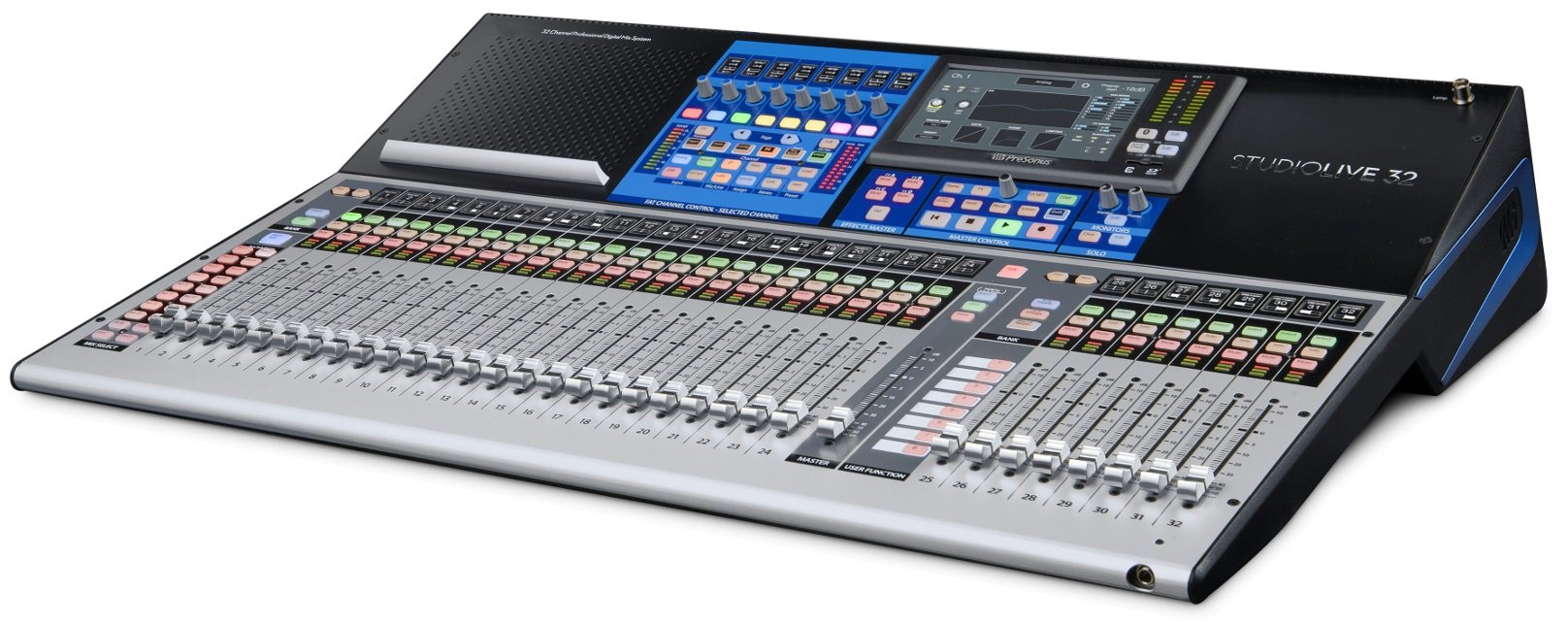
Imagine how many knobs an analog mixer would need if it included this kind of signal processing Definition:
Definition:
Alteration of sound or video signals by using a hardware device or software. Typical signal processing devices include equalization, compression, reverb, color correction, blur, glow, etc. on every channel. Instead, mixers like the StudioLive usually include a limited number of hardware controls for adjusting parameters; when you select a channel, those controls affect the selected channel. But maybe you won’t need to adjust the controls very much anyway, because...
2. You may be forgetful, but your mixer isn’t. With almost all digital mixers, you can save the current setup as a “scene” that you can recall at any time. This makes mixing theatrical productions, house of worship services, musical performances, seminars, panel discussions, or whatever so much easier: push a button, and the settings are exactly as you saved them. Not only can you usually save multiple scenes, but also, it’s typically possible to save settings for channel strips and sometimes even individual effects. Many manufacturers treat these types of presets as an important feature; QSC’s TouchMix-8 (Fig. 2) not only includes presets designed by professional engineers, but Wizards for anti-feedback and room tuning.
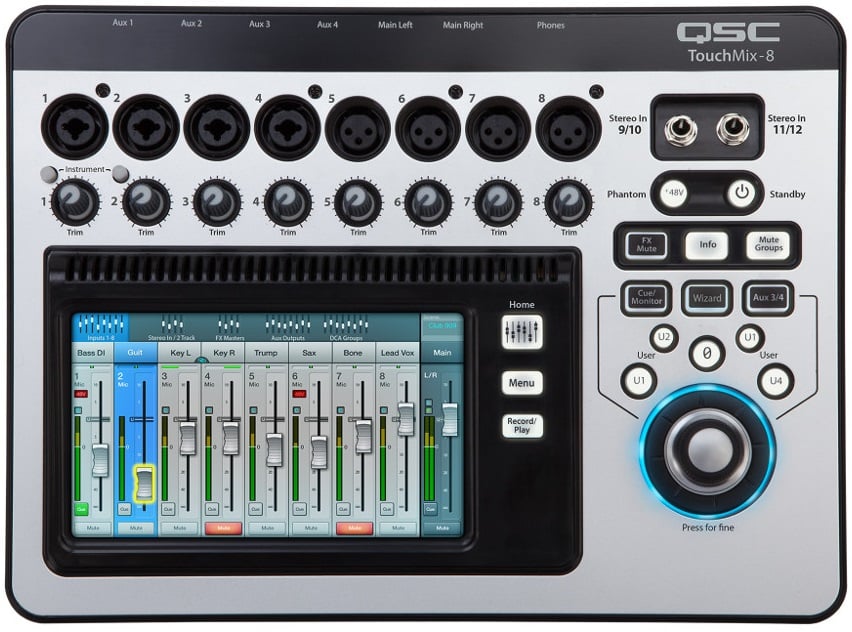
Of course, if you create a sweet preset Definition:
Definition:
1. (verb) Ability to set parameters in advance, and recall those parameter values as desired. 2. (noun) A collection of parameter values stored within a device, or externally. for a vocalist using a particular mic, you can save it, name it, and recall it whenever you want—but even better, some mixers may already include a suitable preset.
3. Digital mixers satisfy your inner control freak. Many mixers have companion remote Definition:
Definition:
A broadcast from the field, not from the studio. A Remote Control. control apps for smartphones, tablets, and laptops. Imagine how cool it is to walk around a venue, mobile device in hand, and optimize the sound to work in a particular venue. Some mixers create their own network so you can hook up via wi-fi Definition:
Definition:
A wireless network protocol for device networking and internet access. Also spelled WiFi, wifi, or Wifi. for control over long distances. There are even mixers that have no hardware control surface Definition:
Definition:
A device that provides mechanical controls, such as switches, rotary controls, and faders to provide hands-on control of software parameters. A typical application is creating a box with faders to control the levels in a software mixer., only I/O Definition:
Definition:
(Input/Output): 1. A pair of connections that provide input(s) and output(s). 2. The connections that link a computer to devices outside the computer., and can be controlled from an iPad—like Behringer’s XR18 (Fig. 3).
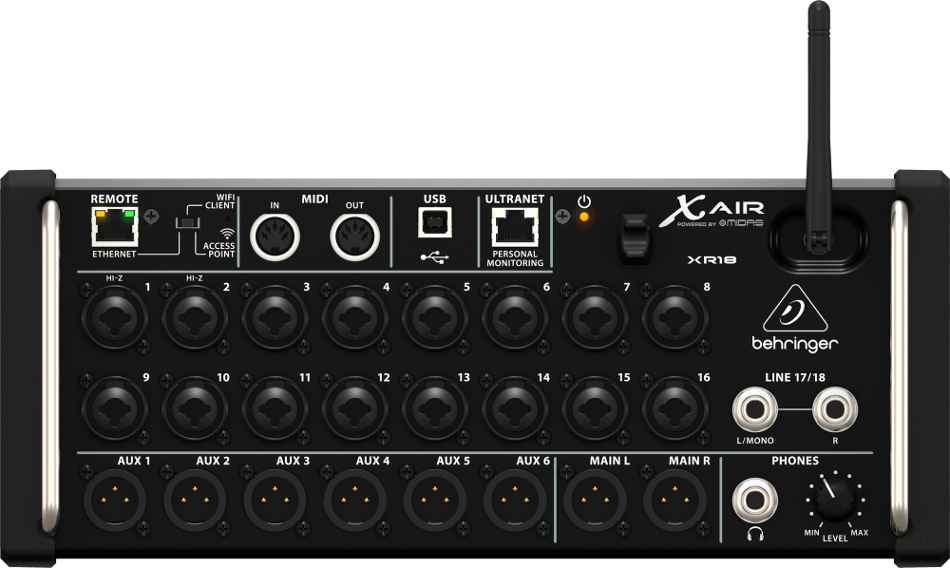
Because you control the XR18 via wi-fi, and there’s no control surface hardware, the price is very reasonable. Bonus coolness: with some apps, more than one person can control the mixer. For example, someone could be paying attention to the monitoring situation for performers onstage, while someone else takes care of the front-of-house mix Definition:
Definition:
What the audience hears at a live performance..
4. Security is a beautiful thing. Another common digital mixer feature is being able to lock out the settings, or particular combinations of settings. When you need to take a break, lock down all the settings so that curious fingers can’t create any nasty surprises when your break is over.
5. Put those fat analog snakes on a digital diet. It’s great to have all your inputs on stage, maybe in a stagebox rack unit, and run them back to your mixer through a snake Definition:
Definition:
A cable with multiple internal cables in a common jacket.. But an analog snake is bulky, expensive, sometimes unreliable, and picks up noise and hum Definition:
Definition:
An undesired continuous signal caused by AC electrical power, typically 60/50 Hz and its harmonics.. A digital snake typically uses a svelte Ethernet Definition:
Definition:
A local area network (LAN) using cables classified according to certain categories (CAT5, CAT6, CAT5e, etc.). These relate to the speed a cable can handle. cable that’s better in every respect, and ignores interference. There are even bundles to get you started, like the Allen & Heath Qu-24C Starter Pack (Fig. 4).
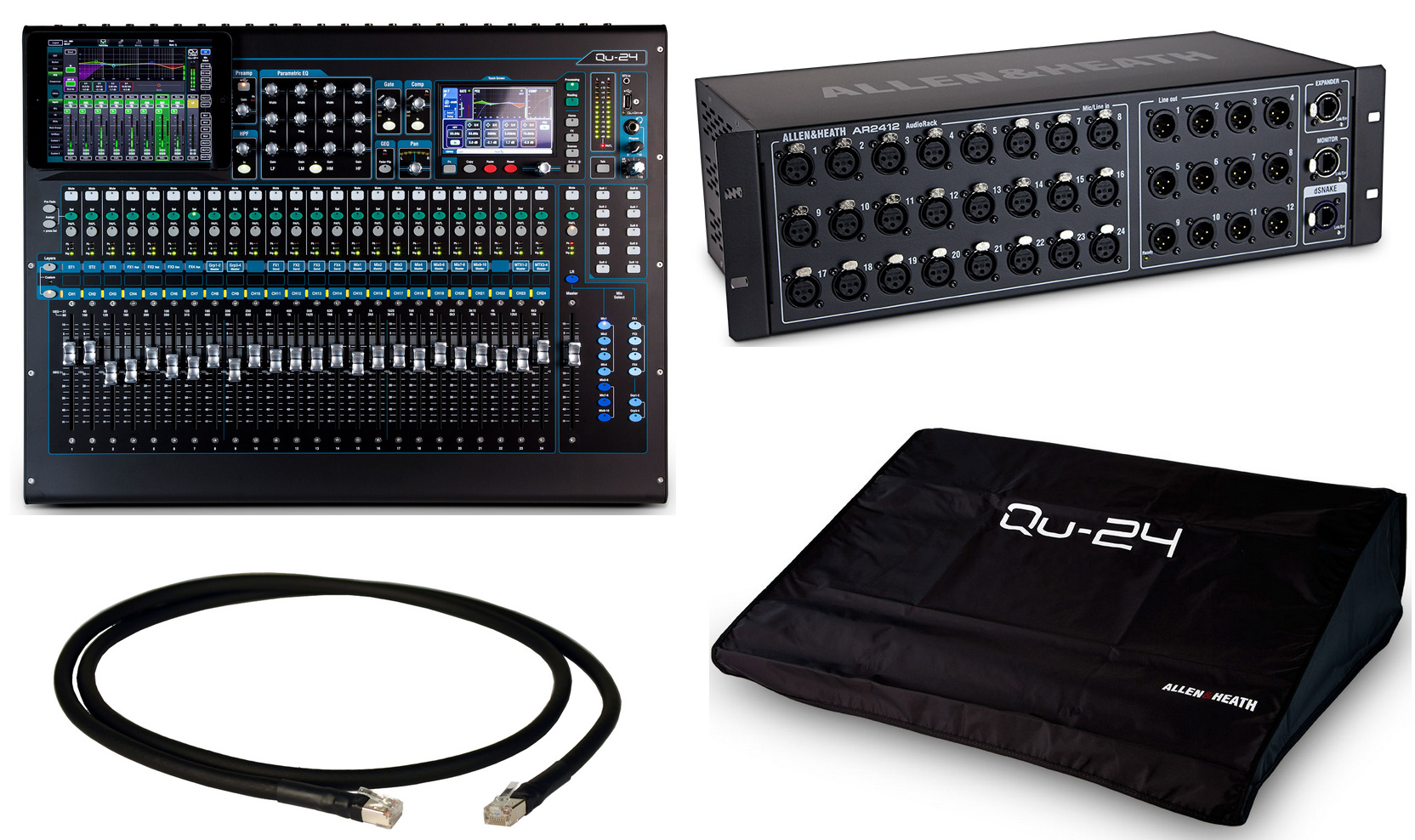
This particular starter pack includes the Qu-24C 24-channel digital mixer and the AR2412 remote audio rack, which has 24 XLR ins and 12 XLRs out. Connecting it to the Qu mixer with a single CAT5 cable allows positioning the AR2412 I/O up to 120 meters away from the mixer. Try that with an analog snake. On second thought...don’t.
6. Or, just get rid of the snake altogether. Remember how Indiana Jones hated snakes in Raiders of the Lost Ark? Well if you hate snakes too, simply tuck away your rack-mount mixer electronics on stage, and control it remotely with an app—as you do with Soundcraft’s Ui24R (Fig. 5).

This 24-channel rackmount digital mixer, with an integral wi-fi router Definition:
Definition:
1. (computers) A networking device that forwards data packets among different computer networks, such as between the internet and home or enterprise computing systems. It may include additional control functions, such as quality of service or security. 2. (broadcast) An audio/visual switcher (matrix)., allows for control from iOS Definition:
Definition:
Apple proprietary operating system, primarily for mobile devices (iPhone, iPad, iPod Touch, Apple Watch). Current Apple TVs run on tvOS, which is similar to, and based on, iOS., Android, Windows, MacOS, and Linux browsers. If you get nostalgic about snakes, though, you can also control the UI24R from up to ten devices over Ethernet—and this mixer even does multitrack Definition:
Definition:
A recorder that can record more than one individual track at a time, or individual tracks in sequence for subsequent mixing. recording.
7. Less can definitely be more. For units of approximately the same size and footprint, compared to an analog mixer, a digital mixer will offer more effects, more functionality, and maybe even weigh less. The compact nature of sophisticated digital mixers, especially units like Yamaha’s TF1 (Fig. 6), is a big deal for many applications.
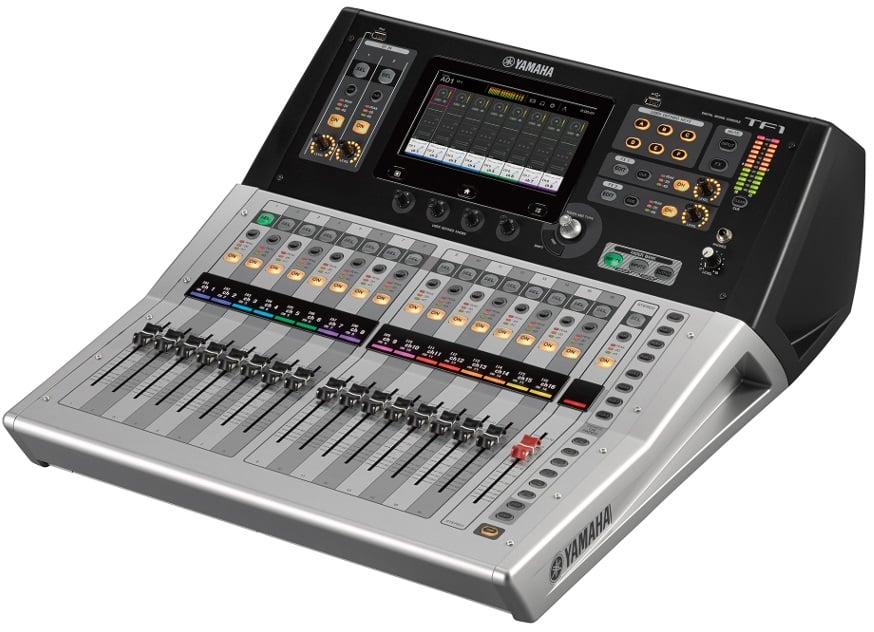
The TF1 packs 17 motorized faders, 16 XLR-1/4” combo inputs (expandable to 40 inputs total), 20 aux buses, 1-knob compression Definition:
Definition:
1. Reducing the dynamic range of an audio or video signal for consistency, to keep it from exceeding the available headroom, or providing a special effect. 2. With data, using a process to reduce the amount of data. Compression can be lossless, where decompressing replicates the original signal, or lossy, where compression occurs by judging some data as unnecessary, and can therefore be discarded from the file., EQ, and a touchscreen (the “TF” stands for TouchFlow) into an under-30-pound package that’s 20.1"W x 23.6"D x 8.9"H.
8. Native multitrack recording. More and more digital mixer companies figure that hey, if the audio is already digital, why not capture it with a built-in digital recorder? The Midas M32 Live 32-channel mixer (Fig. 7) is a good example of this approach.
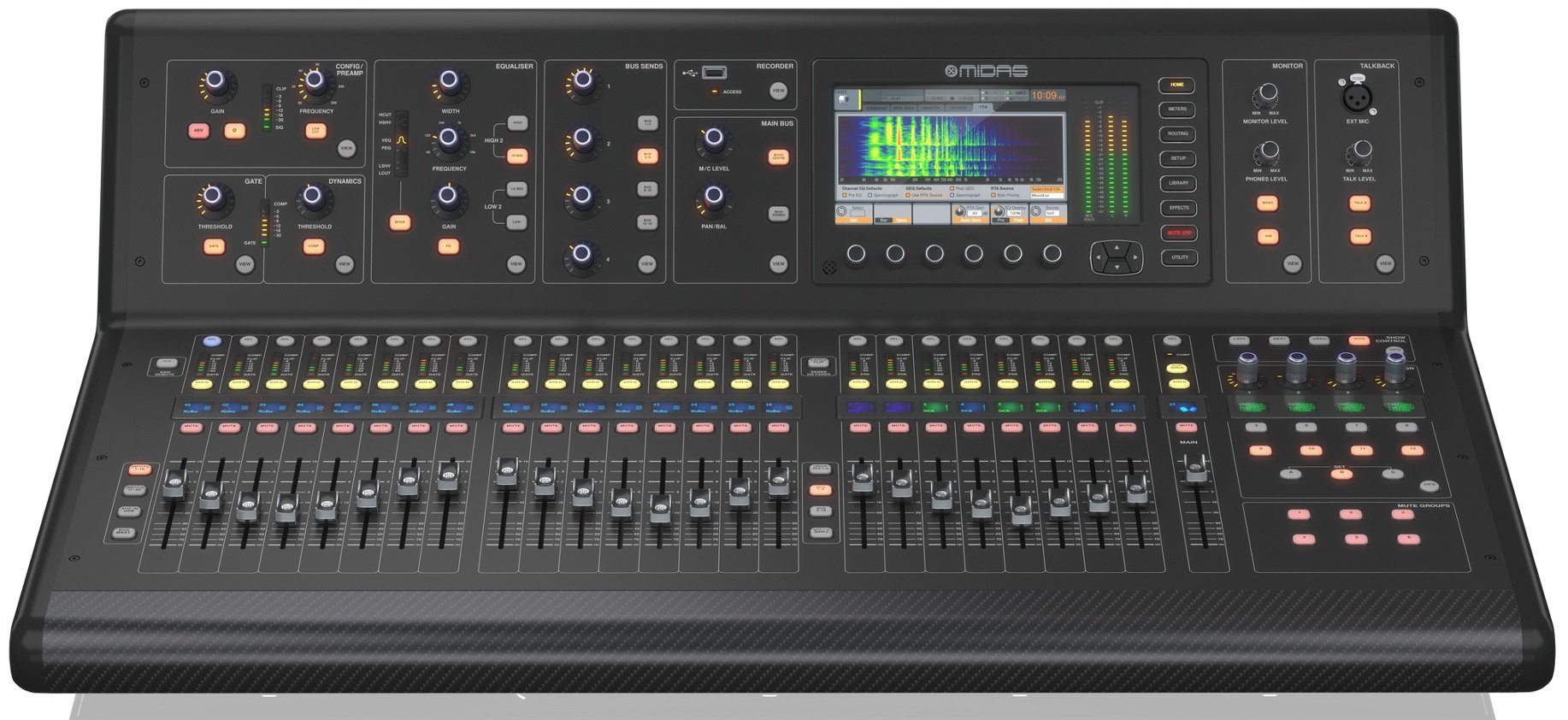
For recording and capturing live performances, the Midas M32 Live offers 32 bi-directional Definition:
Definition:
A microphone or speaker that operates in two directions simultaneously, with one side "in phase" and the other 180-degrees out of phase. Also called "figure-8." channels of live recording/playback on dual SD/SDHC cards, with up to 3 hours of 32-channel, uncompressed WAV Definition:
Definition:
(Waveform Audio File) Audio bit stream file format developed by IBM and Microsoft. file recording in one session.
9. Dante Definition:
Definition:
Dante™ (Digital Audio Network Through Ethernet): The audio-over-IP standard created by Audinate (layer 3). or AVB Definition:
Definition:
AVB (Audio Video Bridging): A network standard by the Avnu Alliance. compatibility. Sometimes you need to run audio over long distances, like in a hotel, airport, megachurch, stadium, or other large venue. Dante and AVB to the rescue: they let you run scads of digital audio over inexpensive Ethernet networks. For more information about Dante, check out the article What is Dante Audio Networking? A Basic Overview.
10. Easier training. This is arguable, because it depends on complexity—a simple analog mixer will be easier to learn than a complex digital one. Regardless, there are several reasons why digital can be better.
- Digital mixers typically have a less “cluttered” layout than analog mixers, which makes them less intimidating.
- Younger engineers are familiar with computers, menu structures, and virtual devices. They can feel right at home with a digital mixer, whereas they may not have much context for a complex analog mixer.
- People can learn a section at a time. Mixers with presets let you store settings for future recall, so it’s easy to have a default
 Definition:
Definition:
A value assumed initially by a device, particularly a computer-based device, until changed. setting where users can experiment as much as they want, yet always end up back at “square one” if needed.
Overall, unless you have very simple needs and a very constrained budget, you’ll often be ahead of the game with a digital mixer. And for large-format mixers, digital offers so many advantages it’s become the leading contender for mixers, whether for studio or stage.
Bear in mind that many digital mixers have some, or even most, of the features mentioned above—each mixer description touches on only some selected highlights. And the universe of digital mixers is way too big to cover in a single article! For more information about which product will best fit your particular needs, call your Full Compass sales guide for expert advice—we’ve been helping people choose mixers for over 40 years.



